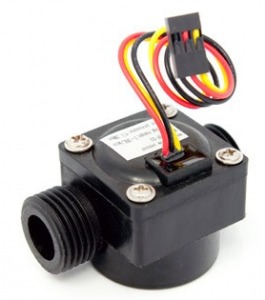A flow meter is the sensor that is used to measure water flow, or the flow of a low-viscosity fluid. There are many different types of flowmeters, but perhaps the most common are turbine or paddlewheel types. In these types of flow meters, a blade spins from the force of the moving fluid. The rotation is detected by a sensor that generates pulses that can be counted by a reader interface.
Older flow meters such as fuel pulsers used a rotating magnet that pulled a tiny reed switch causing the switch contacts to close. Every contact closure results in a pulse at the input of the reader, leading to these flowmeters being called pulsers. There are still thousands of these devices in use.
More modern pulsers and flow meters of all types like the one shown below generate their pulses electronically, often using Hall-Effect sensors that, again, respond to a moving magnet that is spun by a turbine or a paddlewheel.
Now that we have a flowmeter device that can give a pulse output rate that is proportional to the rate that the water or other liquid is flowing at, we need to measure it. The reading device is basically a counter that is calibrated to the pulse rate.
For example, a fuel flowmeter may output 10 pulses per gallon of fuel dispensed, or a flowmeter used for water provides 100 pulses per liter. The reader must understand this calibration so it can display the correct value.
In many cases, the need is to read the flow and record or process the data on a desktop computer. Serial interfaces, RS232 or RS485 and USB are common here. By using a serial port flow meter interface, getting the data into the PC for software processing is a simple task since all modern programming platforms provide some form of serial data communication. Once the data can be received by your software, then you may record it, create graphs, log flow over time, etc.
Cedar Lake Instruments’s PRT232 flow meter interface is a serial port counter flowmeter reader that can measure and record flow. It reads pulser type flow meters, and can switch solenoid valves or pumps to control fluid flow.
If you'd like to subscribe to this blog, please click here.
